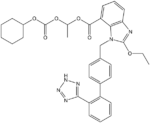Candesartan
 | |
| Clinical data | |
|---|---|
| Trade names | Atacand |
| AHFS/Drugs.com | Monograph |
| MedlinePlus | a601033 |
| Pregnancy category |
|
| Routes of administration | oral |
| ATC code | C09CA06 (WHO) |
| Legal status | |
| Legal status |
|
| Pharmacokinetic data | |
| Bioavailability | 15% (candesartan cilexetil) |
| Metabolism | Candesartan cilexetil: intestinal wall; candesartan: hepatic (CYP2C9) |
| Biological half-life | 9 hours |
| Excretion | Renal 33%, faecal 67% |
| Identifiers | |
| |
| CAS Number |
139481-59-7 |
| PubChem (CID) | 2541 |
| IUPHAR/BPS | 587 |
| DrugBank |
DB00796 |
| ChemSpider |
2445 |
| UNII |
S8Q36MD2XX |
| KEGG |
D00626 |
| ChEBI |
CHEBI:3347 |
| ChEMBL |
CHEMBL1016 |
| ECHA InfoCard | 100.132.654 |
| Chemical and physical data | |
| Formula | C24H20N6O3 |
| Molar mass | 440.45 g/mol |
| 3D model (Jmol) | Interactive image |
| |
| |
| | |
Candesartan (rINN) /ˌkændᵻˈsɑːrtən/ is an angiotensin II receptor antagonist used mainly for the treatment of hypertension. The prodrug candesartan cilexetil is marketed by AstraZeneca and Takeda Pharmaceuticals, commonly under the trade names Blopress, Atacand, Amias, and Ratacand. It is available in generic form.[1]
Clinical use
As with other angiotensin II receptor antagonists, candesartan is indicated for the treatment of hypertension. Results from the CHARM study (early 2000s) demonstrated the morbidity and mortality reduction benefits of candesartan therapy in congestive heart failure.[2] Thus, while ACE inhibitors are still considered first-line therapy in heart failure, candesartan can be used in combination with an ACE to achieve improved mortality and morbidity vs. an ACE alone and additionally is an alternative in patients intolerant of ACE inhibitor therapy.
Prehypertension
In a four-year randomized controlled trial, candesartan was compared to placebo to see whether it could prevent or postpone the development of full-blown hypertension in people with so-called prehypertension. During the first two years of the trial, half of participants were given candesartan, and the others received placebo; candesartan reduced the risk of developing hypertension by nearly two-thirds during this period. In the last two years of the study, all participants were switched to placebo. By the end of the study, candesartan had significantly reduced the risk of hypertension, by more than 15%. Serious side effects were actually more common among participants receiving placebo than in those given candesartan.[3]
Combination with diuretic
Candesartan is also available in a combination formulation with a low dose of the thiazide diuretic hydrochlorothiazide, to achieve an additive antihypertensive effect. Candesartan/hydrochlorothiazide combination preparations are marketed under various trade names including Atacand HCT, Hytacand, Blopress Plus, Advantec and Ratacand Plus.

Chemistry and pharmacology
Candesartan is marketed as the cyclohexyl 1-hydroxyethyl carbonate (cilexetil) ester, known as candesartan cilexetil. Candesartan cilexetil is metabolised completely by esterases in the intestinal wall during absorption to the active candesartan moieity.
The use of a prodrug form increases the bioavailability of candesartan. Despite this, absolute bioavailability is relatively poor at 15% (candesartan cilexetil tablets) to 40% (candesartan cilexetil solution). Its IC50 is 15 µg/kg.
Development history
The compound known as TCV-116 (candesartan) was studied by Japanese scientists using standard laboratory rats. Animal studies were published showing the effectiveness of the compound in 1992-1993, with a pilot study on humans published in the summer of 1993.[4][5]
Research
In a study of 108 patients with early morning blood pressure more than 135/85 mmHg, Candesartan showed significantly early morning Blood Pressure decreased over amlodipine, and also to ARBs, valsartan, losartan, telmisartan, but not olmesartan.[6]
See also
References
- ↑ sandoz.com
- ↑ Pfeffer M, Swedberg K, Granger C, Held P, McMurray J, Michelson E, Olofsson B, Ostergren J, Yusuf S, Pocock S (2003). "Effects of candesartan on mortality and morbidity in patients with chronic heart failure: the CHARM-Overall programme". Lancet. 362 (9386): 759–66. doi:10.1016/S0140-6736(03)14282-1. PMID 13678868.
- ↑ Julius S, Nesbitt SD, Egan BM, et al. (July 2006). "Feasibility of treating prehypertension with an angiotensin-receptor blocker". New England Journal of Medicine. 354 (16): 1685–97. doi:10.1056/NEJMoa060838. PMID 16537662.
- ↑ Mizuno, K.; et al. (1992). "Hypotensive activity of TCV-116, a newly developed angiotensin II receptor antagonist, in spontaneously hypertensive rats.". Life Sci. 51 (20): PL183–187. doi:10.1016/0024-3205(92)90627-2. PMID 1435062.
- ↑ Ogihara, T.; et al. (Jul–Aug 1993). "Pilot study of a new angiotensin II receptor antagonist, TCV-116: effects of a single oral dose on blood pressure in patients with essential hypertension.". Clin Ther. 15 (4): 684–91. PMID 8221818.
- ↑ Shinya Minatoguchi, Takuma Aoyama, Naoki Kawai, Mitsunori Iwasa, Masayuki Oda, Keiji Kida, Syojiro Kojima, Naomi Goto, Masahiro Goto, Fusayoshi Sugishita, Kuniyuki Takai, Ryuhei Tanaka, Keiji Hiei, Taro Minagawa, Noritaka Yamamoto, Ikuo Watanabe, Takao Yasue & Hiroshi Kobayashi. "Comparative effect of candesartan and amlodipine, and effect of switching from valsartan, losartan, telmisartan and olmesartan to candesartan, on early morning hypertension and heart rate". Retrieved September 27, 2016.